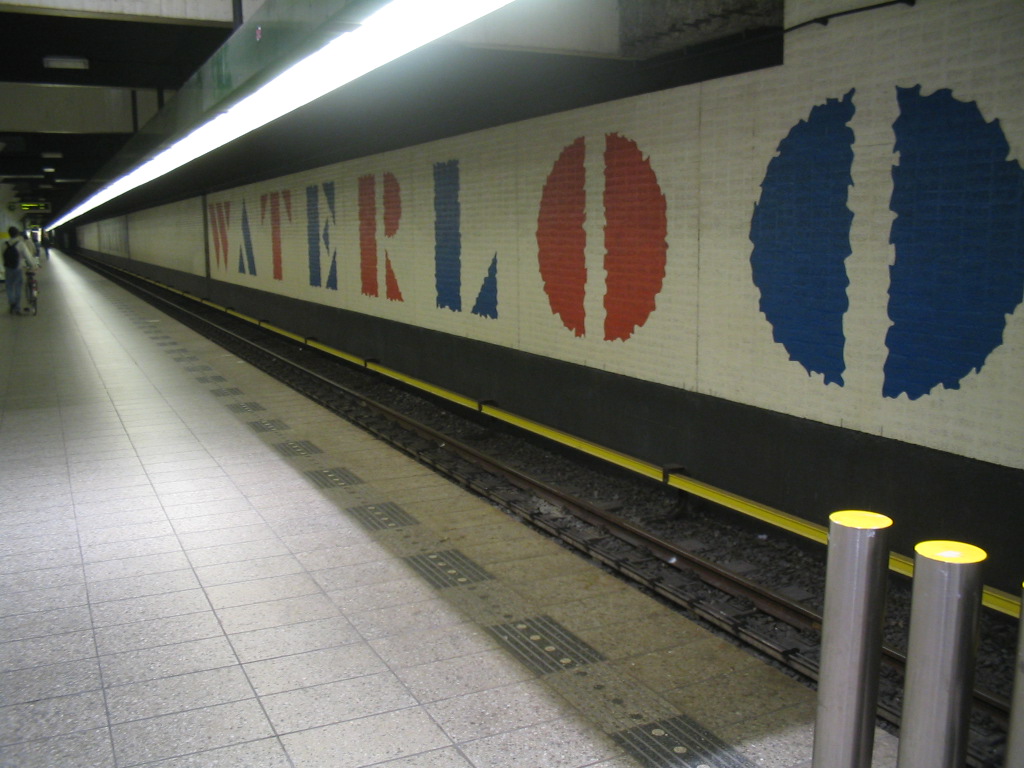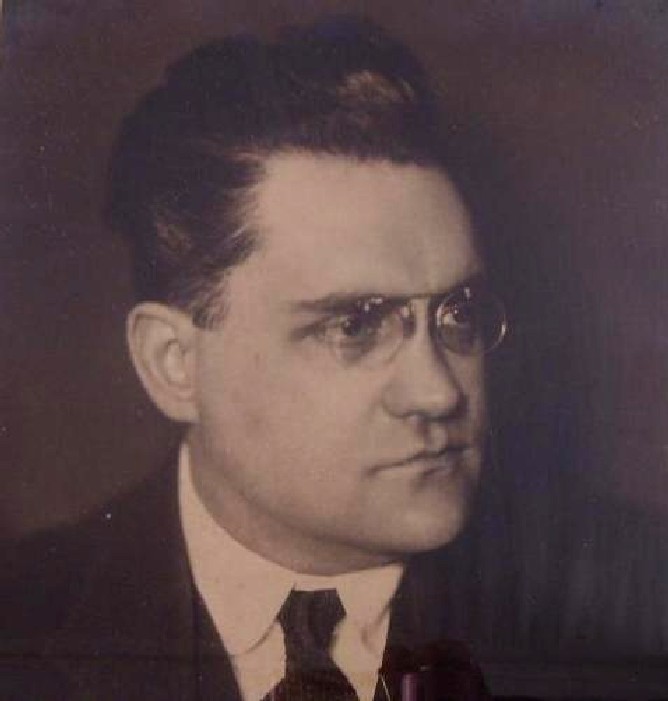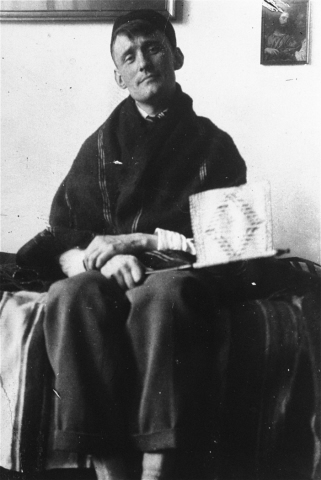|
Willem Sandberg
Jonkheer Willem Jacob Henri Berend Sandberg (24 October 1897 – 8 April 1984) was a Dutch typographer, museum curator, and member of the Dutch resistance during World War II. Early life and career Sandberg was born in Amersfoort in 1897 and studied art in Amsterdam. He became a follower of the Mazdaznan movement. As a young man he traveled, serving as an apprentice to a printer in Herrliberg, Switzerland. In 1927, he visited Vienna, where he studied Otto Neurath's Isotype system at the Gesellschafts- und Wirtschaftsmuseum. At this time, he also visited the Dessau Bauhaus and met Naum Gabo, a pioneer of kinetic art. Returning to Amsterdam, Sandberg started work as a graphic designer, utilizing his printing skills and Neurath's Isotype system. In 1928, he started a long relationship with the Stedelijk Museum, and in 1932 became a member of VANK, the Dutch Society for Arts and Crafts. He soon joined the committee that determined the exhibitions of the museum. From 1937 to 19 ... [...More Info...] [...Related Items...] OR: [Wikipedia] [Google] [Baidu] |
Stedelijk Museum
The Stedelijk Museum Amsterdam (; Municipal Museum Amsterdam), colloquially known as the Stedelijk, is a museum for modern art, contemporary art, and design located in Amsterdam, Netherlands.Stedelijk Museum , I Amsterdam. Retrieved on 26 September 2012. The 19th-century building was designed by Adriaan Willem Weissman and the 21st century wing with the current entrance was designed by Benthem Crouwel Architects. It is located at the Museum Square in the [...More Info...] [...Related Items...] OR: [Wikipedia] [Google] [Baidu] |
1943 Bombing Of The Amsterdam Civil Registry Office
The 1943 bombing of the Amsterdam civil registry office was an attempt by members of the Dutch resistance to destroy the Amsterdam civil registry (''bevolkingsregister''), in order to prevent the Netherlands in World War II, German occupiers from identifying Jews and others marked for persecution, arrest or forced labour. The March 1943 assault was only partially successful, and led to the execution of 12 participants. Nevertheless, the action likely saved many Jews from arrest and deportation to extermination camp, Nazi extermination camps. Background Following the 1940 Battle of the Netherlands, German invasion and occupation of the Netherlands, everyone aged 15 and older was required to carry an identification card, the ''persoonsbewijs'', with them at all times. Jews had to carry a ''persoonsbewijs'' marked with a large J. Resistance members soon started to forge identification cards on a large scale – the largest such operation, led by Gerrit van der Veen, produced some 80, ... [...More Info...] [...Related Items...] OR: [Wikipedia] [Google] [Baidu] |
Jan Van Gilse
Jan Pieter Hendrik van Gilse (11 May 1881 – 8 September 1944) was a Dutch composer and conductor (music), conductor. Among his works are five symphony, symphonies and the Dutch-language opera ''Till Eulenspiegel, Thijl''. Life Coming from a family of theologians, Jan van Gilse showed an early aptitude for piano playing and composing. From 1897 onwards, he studied at the Cologne College or university school of music, conservatory. After his teacher, Franz Wüllner, died in 1902, he continued his studies with Engelbert Humperdinck (composer), Engelbert Humperdinck in Berlin. From 1909 to 1911, he studied in Italy. In 1901, van Gilse received the Beethoven-Haus Prize in Bonn for his ''(First) Symphony in F major''; In 1906, the Michael Beer Prize was awarded to him for his ''Third Symphony, 'Erhebung' ''('Elevation'; for soprano solo and orchestra). In addition to composing, van Gilse soon developed an interest in conducting. He started out with the Theater Bremen, Bremen Opera, ... [...More Info...] [...Related Items...] OR: [Wikipedia] [Google] [Baidu] |
Lau Mazirel
Laura "Lau" Carola Mazirel (29 November 1907 in Utrecht – 20 November 1974 in Saint-Martin-de-la-Mer, France) was a member of the Dutch resistance during World War II who helped organise the 1943 bombing of the Amsterdam civil registry office. An attorney, she was an early proponent of LGBT rights and the rights of Romani people. She opposed civil marriage due to the then-inferior status of women, and also opposed registration of personal information, which she considered a violation of privacy."MAZIREL, Laura Carola", ''Biografisch Woordenboek van het Socialisme en de Arbeidersbeweging in Nederland'' 1992 (Dutch) [...More Info...] [...Related Items...] OR: [Wikipedia] [Google] [Baidu] |
Suzy Van Hall
Helena Suzanna van Hall (April 28, 1907 – July 1978) was a Dutch dancer. She was born in The Hague, the younger sister of sculptor Frits van Hall. In 1932, she married . Van Hall had a dance studio in Paris, performed there and also toured England, Switzerland and Tunisia. The couple grew apart: in part because of the demands of her career and in part because of his affair with their au pair. They divorced in 1938. She was involved in the Dutch resistance during World War II with her lover Gerrit Jan van der Veen. In 1944, she was arrested and convicted of manufacturing false identification, robbery and other offences; she was sent to Herzogenbusch concentration camp, Herzogenbusch, Ravensbrück concentration camp, Ravensbrück, and finally Dachau concentration camp, Dachau concentration camp. Van Hall was liberated in April 1945. After her release, she was taken in by Koos Schregardus and was given a position in the publishing company . Schregardus and van Hall published ... [...More Info...] [...Related Items...] OR: [Wikipedia] [Google] [Baidu] |
Martinus Nijhoff
Martinus Nijhoff (20 April 1894, in The Hague – 26 January 1953, in The Hague) was a Dutch poet and essayist. He studied literature in Amsterdam and law in Utrecht. His debut was in 1916 with his volume ''De wandelaar'' ('The Wanderer'). He then gradually expanded his reputation by his unique style of poetry: not experimental, like Paul van Ostaijen, yet distinguished by the clarity of his language combined with mystical content. He was a literary craftsman who employed skillfully various verse forms from different literary periods. Some of his best-known works include ('The U Hour', 1936) and the long poem (1934). A number of individual sonnets also rose to fame, particularly ('The Mother the Woman') commemorating the opening of a bridge over the river Waal near Zaltbommel. Joseph Brodsky Iosif Aleksandrovich Brodsky (; ; 24 May 1940 – 28 January 1996) was a Russian and American poet and essayist. Born in Leningrad (now Saint Petersburg) in the Soviet Union, Brod ... [...More Info...] [...Related Items...] OR: [Wikipedia] [Google] [Baidu] |
Frieda Belinfante
Frieda Belinfante (May 10, 1904 – March 5, 1995) was a Dutch cellist, philharmonic conductor, a prominent lesbian, and a member of the Dutch resistance during World War II. After the war, Belinfante emigrated to the United States and continued her career in music. She was the founding artistic director and conductor of the Orange County Performing Arts Center, Orange County Philharmonic. Early life and education Belinfante was born 1904 in Amsterdam the third of four children of Aron Belinfante and Georgine Antoinette Hesse. Her father was a prominent pianist and director of a music school in Amsterdam. According to Belinfante, her father was Jewish and her mother was Christian but her upbringing was secular. Belinfante attended the local public school until the seventh grade. At the insistence of her father that each child play a musical instrument, Belinfante began to study cello at the age of 10. She graduated from the Amsterdam Conservatory. Career Belinfante made her profe ... [...More Info...] [...Related Items...] OR: [Wikipedia] [Google] [Baidu] |
Frits Van Hall
Frederik Jan (Frits) van Hall (8 May 1899 (Suikerfabriek Bodja near Semarang) – 18 January 1945 (Gliwice) was a Dutch sculptor executed for his role in the Dutch resistance in 1945. Frits was born near Semarang in the Dutch East Indies. His family returned to the Netherlands in 1905. His sister, the dancer Suzy van Hall, was born in 1907. His work includes the Van Heutsz monument, the Moerdijk monument and the decoration of the Enschede town hall. Gallery File:Denhaag kunstwerk ot en sien.jpg, ''Ot en Sien'', Den Haag File:Moerdijkbrug.jpg, Monument Moerdijkbrug 1978 File:Monument Indië-Nederland Amsterdam.jpg, ''Monument Indië-Nederland'', Amsterdam File:Bergen op zoom kunstwerk rechtvaardigheid.jpg, ''Rechtvaardigheid'', Bergen op Zoom Bergen op Zoom (; called ''Berrege'' in the Brabantian dialect, local dialect) is a List of cities in the Netherlands by province, city and Municipalities of the Netherlands, municipality in southwestern Netherlands. It is located in th ... [...More Info...] [...Related Items...] OR: [Wikipedia] [Google] [Baidu] |
Gerrit Van Der Veen
Gerrit van der Veen (26 November 1902 – 10 June 1944) was a Dutch sculptor. He was a member of the Dutch underground, which resisted the German occupation of Amsterdam during World War II. The historian Robert-Jan van Pelt wrote: In 1940, after the German occupation, van der Veen was one of the few who refused to sign the so-called “Arierverklaring,” the Declaration of Aryan Ancestry. In the years that followed, he tried to help Jews both in practical and symbolic ways. Together with the musician Jan van Gilse and the (openly homosexual) artist, art historian, and critic Willem Arondeus, van der Veen established the underground organization De Vrije Kunstenaar (The Free Artist). Van der Veen and the other artists published a newsletter calling for resistance against the occupation. When the Germans introduced identity documents (Persoonsbewijzen) that distinguished between Jews and non-Jews, van der Veen, Arondeus and the printer produced some 80,000 false identity pape ... [...More Info...] [...Related Items...] OR: [Wikipedia] [Google] [Baidu] |
Willem Arondeus
Willem Johan Cornelis Arondéus (22 August 1894 – 1 July 1943) was a Dutch artist and author who joined the Dutch resistance, Dutch anti-Nazi resistance movement during World War II. He participated in 1943 bombing of the Amsterdam civil registry office, the bombing of the Amsterdam public records office to hinder the History of the Jews in the Netherlands#The Holocaust, Nazi German effort to identify Dutch Jews and others wanted by the Gestapo. Arondéus was caught and executed soon after his arrest. Yad Vashem recognized Arondéus as Righteous Among the Nations. Arondéus was openly gay before the war and defiantly asserted his sexual orientation before his execution. His last words were: "Tell people that homosexuals are not cowards." Early life Willem Johan Cornelis Arondéus was born in Naarden, as the youngest son of an Amsterdam fuel trader. His parents were Hendrik Cornelis Arondéus and Catharina Wilhelmina de Vries. He started working as an illustrator, designer of p ... [...More Info...] [...Related Items...] OR: [Wikipedia] [Google] [Baidu] |
Binnenlandse Strijdkrachten
The ''Binnenlandse Strijdkrachten'' (BS; ), fully the ''Nederlandse Binnenlandse Strijdkrachten'' (NBS), was a government-sanctioned union of Dutch resistance, Dutch resistance groups during the Netherlands in World War II, German occupation of the Netherlands in World War II, which had hardly cooperated until then. History Until 1944 the resistance groups, insofar as they were in contact, worked independently under the supervision of the ''Bureau Bijzondere Opdrachten'' (BBO, 'Office of Special Assignments') of the Dutch government-in-exile in London. When they were merged into the ''Binnenlandse Strijdkrachten'', Prince Bernhard of Lippe-Biesterfeld was appointed commander of this new organization, although he remained in London. The commander of the BS in the occupied Netherlands was Colonel w:nl:Henri Koot, Henri Koot, who was in Amsterdam. At the time the groups were united, they had less than 10,000 members between them. They were also very poorly armed, though this would ... [...More Info...] [...Related Items...] OR: [Wikipedia] [Google] [Baidu] |






